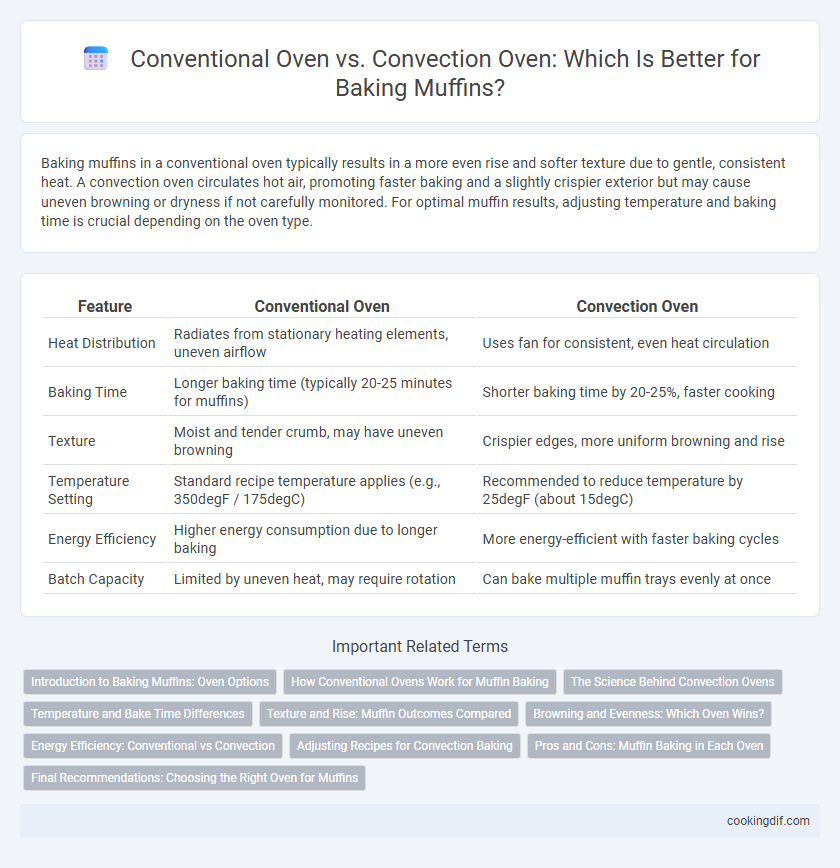Baking muffins in a conventional oven typically results in a more even rise and softer texture due to gentle, consistent heat. A convection oven circulates hot air, promoting faster baking and a slightly crispier exterior but may cause uneven browning or dryness if not carefully monitored. For optimal muffin results, adjusting temperature and baking time is crucial depending on the oven type.
Table of Comparison
| Feature | Conventional Oven | Convection Oven |
|---|---|---|
| Heat Distribution | Radiates from stationary heating elements, uneven airflow | Uses fan for consistent, even heat circulation |
| Baking Time | Longer baking time (typically 20-25 minutes for muffins) | Shorter baking time by 20-25%, faster cooking |
| Texture | Moist and tender crumb, may have uneven browning | Crispier edges, more uniform browning and rise |
| Temperature Setting | Standard recipe temperature applies (e.g., 350degF / 175degC) | Recommended to reduce temperature by 25degF (about 15degC) |
| Energy Efficiency | Higher energy consumption due to longer baking | More energy-efficient with faster baking cycles |
| Batch Capacity | Limited by uneven heat, may require rotation | Can bake multiple muffin trays evenly at once |
Introduction to Baking Muffins: Oven Options
Baking muffins requires precise temperature control and even heat distribution to achieve a moist, fluffy texture. Conventional ovens use static heat from the top and bottom, which can cause uneven baking and longer cooking times for muffins. Convection ovens circulate hot air with a fan, promoting faster, more uniform baking and a better rise, making them ideal for consistent muffin results.
How Conventional Ovens Work for Muffin Baking
Conventional ovens bake muffins by surrounding them with consistent, radiant heat from the top and bottom elements, allowing even rising and browning of the muffin batter. The still air inside conventional ovens creates a stable environment that ensures a tender crumb and moist texture while preventing rapid drying. This method is ideal for achieving classic muffin characteristics, especially when baking in standard-sized pans at moderate temperatures.
The Science Behind Convection Ovens
Convection ovens utilize a fan and exhaust system to circulate hot air evenly around muffins, promoting uniform baking and superior browning compared to conventional ovens that rely on radiant heat. The continuous airflow in convection ovens accelerates moisture evaporation, resulting in a crispier crust while maintaining a tender interior. This scientific principle enhances heat transfer efficiency, reducing baking time and producing consistently textured muffins.
Temperature and Bake Time Differences
Convection ovens circulate hot air evenly, allowing muffins to bake at temperatures 25degF lower than conventional ovens, typically reducing bake time by 20%. Conventional ovens rely on static heat, requiring higher temperatures and longer durations, which can result in uneven muffin rise and browning. Adjusting temperature and timing in convection ovens ensures consistent texture and golden crust for perfectly baked muffins.
Texture and Rise: Muffin Outcomes Compared
Convection ovens promote even heat circulation, resulting in muffins with a consistent rise and a slightly crisp exterior texture. Conventional ovens provide gentler, less uniform heat, which can create muffins with a softer crumb but occasionally uneven rising. For optimal muffin texture and lift, convection ovens typically yield a lighter, fluffier interior and more uniform dome compared to conventional ovens.
Browning and Evenness: Which Oven Wins?
Convection ovens provide superior browning and evenness when baking muffins due to their built-in fans that circulate hot air uniformly, preventing hot spots and promoting consistent crust development. Conventional ovens tend to produce uneven browning with potential soggy tops or undercooked centers, as heat rises without circulation. For perfectly browned muffins with uniform texture, convection ovens are the preferred choice among bakers.
Energy Efficiency: Conventional vs Convection
Convection ovens use a fan to circulate hot air, resulting in faster and more even muffin baking with lower energy consumption compared to conventional ovens. Conventional ovens require longer preheating and baking times, increasing overall energy usage. Energy-efficient convection baking not only saves electricity but also enhances muffin texture by promoting uniform heat distribution.
Adjusting Recipes for Convection Baking
When baking muffins in a convection oven, reduce the temperature by 25degF compared to conventional oven settings to prevent over-browning and ensure even cooking. Convection ovens circulate hot air, promoting faster and more uniform heat distribution, which means baking times may be shorter by 5 to 10 minutes. Adjusting the recipe by monitoring closely and testing doneness earlier helps achieve moist, well-risen muffins with a tender crumb.
Pros and Cons: Muffin Baking in Each Oven
Conventional ovens provide even heat distribution that enhances the rise and texture of muffins but may require longer baking times and occasional hot spots causing uneven browning. Convection ovens use a fan to circulate hot air, resulting in faster, more uniform baking and a crisper crust, yet they can dry out muffins if baking time or temperature isn't adjusted properly. Bakers often prefer conventional ovens for moist, tender muffins, while convection ovens excel in producing consistent results with a golden exterior.
Final Recommendations: Choosing the Right Oven for Muffins
Convection ovens provide even heat distribution and faster baking times, resulting in muffins with a consistent golden crust and moist interior. Conventional ovens are ideal for those seeking gentle, steady heat that prevents over-browning and allows for classic muffin texture. For optimal muffin baking, select convection ovens for efficiency and browning or conventional ovens for traditional, controlled baking outcomes.
Conventional oven vs Convection oven for baking muffins Infographic

 cookingdif.com
cookingdif.com